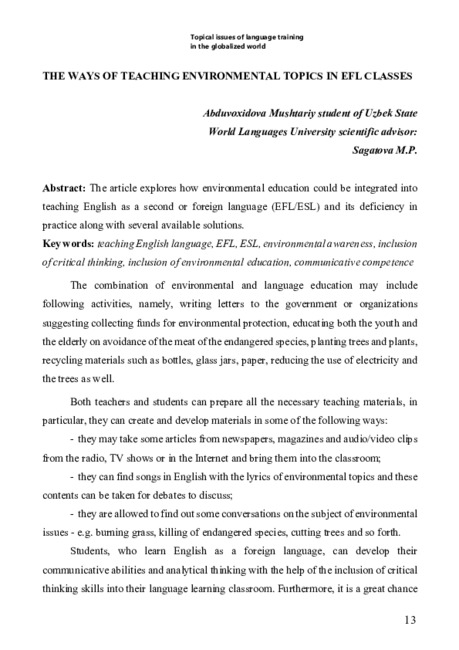
Topical issues of language training
in the globalized world
13
THE WAYS OF TEACHING ENVIRONMENTAL TOPICS IN EFL CLASSES
Abduvoxidova Mushtariy student of Uzbek State
World Languages University scientific advisor:
Sagatova M.P.
Abstract:
The article explores how environmental education could be integrated into
teaching English as a second or foreign language (EFL/ESL) and its deficiency in
practice along with several available solutions.
Key words:
teaching English language, EFL, ESL, environmental awareness, inclusion
of critical thinking, inclusion of environmental education, communicative competence
The combination of environmental and language education may include
following activities, namely, writing letters to the government or organizations
suggesting collecting funds for environmental protection, educating both the youth and
the elderly on avoidance of the meat of the endangered species, planting trees and plants,
recycling materials such as bottles, glass jars, paper, reducing the use of electricity and
the trees as well.
Both teachers and students can prepare all the necessary teaching materials, in
particular, they can create and develop materials in some of the following ways:
-
they may take some articles from newspapers, magazines and audio/video clips
from the radio, TV shows or in the Internet and bring them into the classroom;
-
they can find songs in English with the lyrics of environmental topics and these
contents can be taken for debates to discuss;
-
they are allowed to find out some conversations on the subject of environmental
issues - e.g. burning grass, killing of endangered species, cutting trees and so forth.
Students, who learn English as a foreign language, can develop their
communicative abilities and analytical thinking with the help of the inclusion of critical
thinking skills into their language learning classroom. Furthermore, it is a great chance

Topical issues of language training
in the globalized world
14
to apply communicative skills in various situations when debating on global
environmental issues.
Ideological aspects of language use and the ways related to social issues are
critical linguistic awareness which is an approach to language awareness. The role of
critical thinking in students' behavior is pretty defined. Dowden [2002], for example,
believes that to think critically, among other things, is to be honest and have an open
mind when considering what to do or what to believe. For Scrivener and Paul [2004] to
think critically involves: “...that mode of thinking - about any subject, content or
problem— in which the thinker improves the quality of his or her thinking by skillfully
taking charge of the structures inherent in thinking and imposing intellectual standards
upon them...” Briefly, critical thinking is self-directed, self-disciplined and self-
monitored thinking. A critical thinker, actually, the one who constantly asks questions
in order to distinguish between opinions and facts. Thinking critically is a process in
which a learner makes a decision what to follow or not along with incorporating the
necessary skills that leads to the right decision.
The awareness of critical thinking in the classroom is crucial because it makes
students focus on environmental issues and urges to take an action. Besides, when we
think critically, we automatically question our relationship to it.
Frequently asked questions when teachers face with the inclusion of
environmental education with EFL/ESL learners:
1)
Should be each lesson held outside - in the nature?
2)
Which methods are more appropriate when we teach languages
simultaneously with global education?
3)
How can we provide materials for global education?
4)
How is the simultaneous assessment of both skills?
The infusion of global education in the teaching of English as a second language
does not necessarily mean that each lesson should be held outside, each activity and
each group discussion should be on some global issues. Content based and task based
methods are one of the most appropriate and available ones. The main recommendation

Topical issues of language training
in the globalized world
15
is that environmental education should be a regular and permanent part of the
curriculum, not just something thrown in accidentally once or twice a year.
Many researchers have come to the conclusion that the communicative approach is
a great variety of procedures used in the classroom for the following causes:
o
Communicative competence should be the goal of language learning.
o
When learners learn a language, they learn it to communicate.
o
The goal of classroom activities should be authentic and meaningful
communication.
o
The most essential dimensions of communication are fluency and accuracy.
o
The integration of different language skills can be involved in communication.
o
Trial and error may occur because learning is a gradual process.
The communicative approach plays a dominant role in second language instruction
because of the fact that languages are best learned when they are used to communicate
meaning, rather than when it is concentrated only on explicit learning of grammar and
vocabulary. One of the ways of keeping this focus on meaning is through contemporary
teaching approaches such as the content-based and task-based teaching which are all
applications of the communicative approach.
References
:
1.
Dowden, B. 2002: Definition of critical thinking, Available
at:
http://www.csus.edu/indiv/d/ dowdenb/4/ct- def/def-of-ct.htm
2.
Scrivener, M. & Paul, R. 2004: Defining critical thinking, Available
at:
3.
http://www.criticalthinking.org/aboutCT/define critical thinking.cfm
4.
Далиева, Мадина Хабибуллаевна. "THEORETICAL FEATURES OF
POLYSEMY IN LINGUISTIC TEXTS." МЕЖДУНАРОДНЫЙ ЖУРНАЛ
ИСКУССТВО СЛОВА 5.5 (2022).
5.
Khabibullaevna, Dalieva Madina. "CONCEPT AS THE BASIS OF THE
LINGUISTIC PICTURE OF THE WORLD." British View 8.9 (2023).
6.
Dalieva, Madina. "THE INFLUENCE OF CULTURAL AND HISTORICAL

Topical issues of language training
in the globalized world
16
FACTORS ON THE TERM CONCEPTUALIZATION OF THE SCIENTIFIC AND
LINGUISTIC PICTURE OF THE WORLD." Open Access Repository 9.11 (2023):
11-14.
7.
Madina, Dalieva. "TERMINOCONCEPTUALIZATION OF THE SCIENTIFIC
AND LINGUISTIC PICTURE OF THE WORLD." EPRA International Journal of
Research and Development (IJRD) 8.10 (2023): 198-200.






